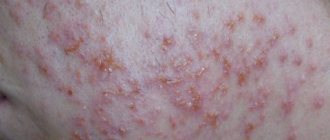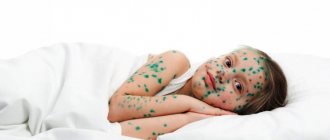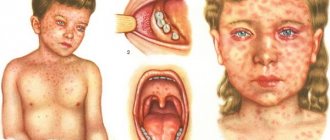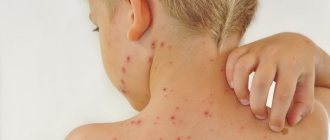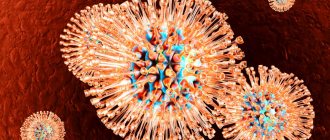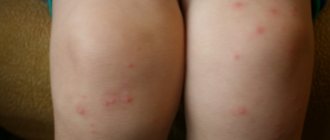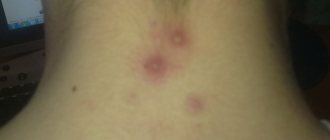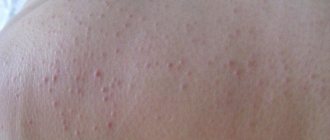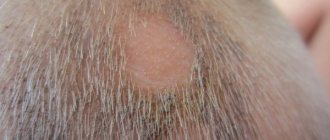Measles is an infectious disease transmitted by a virus. The disease is common among children due to easy infection, and is characterized by a rapid and acute course. In the initial stages, it is easy to confuse it with other viral diseases, but you need to make an accurate diagnosis, because the disease has its own principles of treatment.
The severity of each patient has its own, but it is noted that younger children tolerate the period of illness much easier. Vaccination does not always prevent infection, but today it is the most well-known method of prevention to avoid measles.
In this article you will learn: how measles manifests itself - symptoms in children, rash, photos, therapeutic treatment, eliminating rashes using a folk method.
Kawasaki syndrome.
Wikimedia Commons
Like measles, Kawasaki syndrome causes a rash and conjunctivitis. However, there are additional symptoms: crimson tongue, cracked lips, redness on the palms and soles.
https://www.youtube.com/watch?v=uFzMX8A2NGs
Kawasaki syndrome is a serious disease that requires hospital treatment and causes heart complications.
We remind you that the best protection against measles is vaccination! Don't refuse vaccination!
Measles is a dangerous viral disease that is highly contagious and transmitted by airborne droplets. The disease is characterized by fever, rash and symptoms of intoxication of the body. The disease occurs not only in children, but also in adults. With measles, there is a high risk of developing dangerous complications, including death, so it is important to start treatment in a timely manner.
Prevention
The main role in the prevention of measles in children belongs to active immunization. Vaccination is based on the process of artificially creating an immune response to infections by introducing into the body the protein components of bacteria and viruses that cause the development of infectious processes.
When the first signs of the disease appear, parents are obliged to isolate the child from other children and call a local pediatrician at home; if the child attended a child care institution (kindergarten, school), the mother must inform this institution about the child’s illness. General recommendations:
- isolation of children with measles from the group;
- compliance with quarantine measures in groups for 21 days;
- regular ventilation and wet cleaning of premises, especially if there was a sick child there;
- timely administration of immunoglobulin to contact children no later than 3-5 days from the moment of contact;
- routine vaccination and revaccination of children according to the vaccination calendar.
Recurrence of measles occurs in extremely rare cases. After an illness, immunity is lifelong. After vaccination, stable immunity remains for 15 years.
If you notice the appearance of a rash in a child, you should consult a doctor, he will help you with his explanations. It is important to remember that it is not the virus itself that is dangerous, but the negative consequences in the form of complications that it often has.
Source: pediator4d.ru
Allergic reaction
An allergy is the body's reaction to an antigen that the human immune system perceives as a threat. In other words, an allergy rash is a response to contact with allergens. The latter may include medications, plant pollen, pet hair, food, mold and other factors.
In adults, allergic rashes appear as rashes called hives—small red blisters that resemble a nettle burn. Also, manifestations of eczema can signal individual intolerance.
Red rashes accompanied by intense itching are called toxicoderma or contact dermatitis. In addition to the rash, contact dermatitis is manifested by redness of the affected area of the skin, its soreness, as well as a local increase in temperature. The rash resembles small blisters or red spots grouped in small areas. It is always accompanied by severe itching.
Many people are interested in how to distinguish allergic rashes from other types of rashes. Two factors will help you with this.
- First of all, allergic rashes always occur after direct contact with a certain allergen substance. As a rule, the connection between interaction with an allergen and the appearance of a rash can be traced without problems.
- In addition, with an allergic reaction, the rash usually appears as spots or blisters. It is never pustular or nodular.
However, this does not mean that an allergic rash is harmless. Individual elements of such rashes can merge, covering extremely large areas. This causes itching, pain and inflammation.
At the same time, one should not assume that itchy skin occurs only with allergic rashes. Discomfort in the rash area itself cannot be considered a sign that the symptom arose as a reaction to an allergen. A final diagnosis can be made only after allergy tests are carried out, which will help detect the provoking allergen.
Preventing measles
Prevention of measles is achieved by developing active and passive immunity. For these purposes, immunoglobulin or a vaccine containing a live attenuated virus can be used.
Passive measles prevention
For passive prevention of measles, immunoglobulin is used; it must be administered to a person who has been in contact with a person with measles no later than 72 hours. The drug contains an active protein fraction, which is isolated from donor plasma. The vaccine is released in 1.5 ml ampoules containing one dose of the active substance, or 3 ml ampoules containing two doses. The package contains 10 ampoules. Immunoglobulin is stored in the refrigerator, the shelf life of the drug is two years.
Types of rash
Rashes on the body can manifest themselves in different ways. The rash may have different localization, shape of elements, color. Let's look at the most common types of skin rashes.
Spots (macula) are rashes, the elements of which are located at the level of the skin and do not rise above its surface. Depending on the color of the spots, roseola (red), vitiligo (white spots) and areas of limited pigmentation (brown spots) are distinguished.
Blisters are individual elements of the rash raised above healthy skin. Their surface is dense and rough.
Papules in appearance resemble nodules that are located deep in the skin. They are solid formations that do not have an internal cavity. The size can vary from the head of a pin to the size of a pea.
Bubbles are cavities filled with liquid contents, which are usually colorless. Bubbles are divided into vesicles (small) and bullae (large). If the bladder contains pus, it is called a pustule.
Erosions are elements that differ in size and depth of damage. They are characterized by a violation of the integrity of the skin. In addition, there is discharge, which can be either transparent or cloudy.
Plaques are large papules or a group of several papules.
What does a skin allergy look like?
An allergic reaction on the human body can appear at any age. It affects the skin of children and adult patients with equal frequency. The main manifestations of the disease are numerous or single red rashes in the form of spots on different parts of the body, which are accompanied by unpleasant sensations, in particular, intense itching and a tingling feeling. Often the surface of the spots peels off, cracks, or even becomes covered with purulent crusts (in case of infection).
Red spots on the body, as well as allergies on the legs and arms, are one of the most important signs signaling problems within the body. Manifestations can take the form of small roundness or be diffuse, affecting fairly large areas of the skin. Such rashes, as a rule, do not rise above the surface of the skin; they can appear quickly and disappear just as suddenly. Allergies on the legs, arms and other parts of the body are very itchy, which leads to scratches and infection in places where a person actively scratches the skin.
Possible complications
The cause of measles complications is the effect of the virus on the patient’s immune system. In the peripheral blood, the number of T-lymphocytes sharply decreases. Allergization of the body to the protein components of viruses contributes to the development of inflammation, which leads to increased permeability of small vessels and damage to their walls. In the mucous membranes of organs and tissues (usually the respiratory and digestive systems), catarrhal-necrotic inflammation develops.
- The layering of a secondary (viral-bacterial) infection leads to the development of a number of purulent-necrotic inflammatory processes in the nose, larynx, trachea, bronchi and lung tissue.
- Stomatitis and colitis develop.
- With the disease, conjunctivitis always develops. The cornea of the eye is often affected.
- During the period of pigmentation, inflammation of the middle ear often occurs.
- Under unfavorable sanitary and hygienic conditions, pustular lesions of the skin caused by streptococci and staphylococci develop.
- Microcirculation disorders in the brain lead to hypoxia and encephalopathy develops. Measles encephalopathy is more often recorded in young children. More severe complications of measles are encephalitis and meningoencephalitis. Pathology develops on days 5–7 of the disease. The course of the disease is severe, with a high mortality rate (up to 10%). Surviving children (about 40%) often have mental disorders and epilepsy.
- Damage to the optic and auditory nerves always results in serious consequences. Damage to the spinal cord leads to pelvic disorders.
- Very rarely, myocarditis, hepatitis and glomerulonephritis develop as a result of measles infection.
We suggest that you familiarize yourself with Treating the udder with folk remedies
Fig. 12. The photo shows measles in children. The addition of a secondary infection leads to the development of bacterial conjunctivitis. The conjunctiva of the eyes becomes hyperemic, the eyelids swell, and purulent discharge appears from the eyes.
How dangerous is measles for children? The negative consequences of the disease arise mainly due to a strong weakening of the body’s immune defense and the addition of a bacterial infection. Most often the disease is complicated by the following pathologies:
- otitis – inflammation of various parts of the ear of a chronic or acute nature;
- laryngitis – inflammation of the mucous layer of the larynx;
- pneumonia;
- stomatitis – ulcerative lesions of the oral mucosa;
- development of blindness;
- inflammation of the trachea;
- severe pathologies of the central nervous system;
- encephalitis - inflammation of the membranes of the brain.
Such manifestations are most common in young children. In this regard, they should be treated for measles only in a clinical setting under the strict supervision of a doctor.
Health-threatening complications after measles usually develop in children under 5 years of age. Most often this is:
- otitis;
- laryngitis;
- bronchopneumonia;
- stomatitis;
- blindness;
- encephalitis;
- inflammation of the lymph nodes in the neck;
- tracheobronchitis;
- polyneuritis;
- damage to the central nervous system.
Complications after measles in children are far from uncommon, so treatment must be carried out under constant medical supervision. Ideally, a local doctor should visit a small patient every 2-3 days.
Diagnostics
Diagnosis of measles, which occurs without complications and with a typical picture - ARVI symptoms and a characteristic rash, is simple and is based on examination of the sick child. To identify atypical forms and when the temperature rises again, signaling the addition of a bacterial infection, laboratory tests and instrumental studies are prescribed:
- general blood test, study of its coagulability;
- serological tests using ELISA and PCR methods;
- collection of cerebrospinal fluid;
- smears of bronchial discharge (RIF study).
Instrumental methods usually include chest x-ray and echocardiography. Despite the ease of recognizing measles, when making a diagnosis, doctors have to exclude other diseases that may have a similar symptomatic picture.
Differential diagnosis is carried out to exclude rubella and scarlet fever.
IMN, an infectious mononucleosis that is sometimes confused with tonsillitis and antibiotics are prescribed for its treatment, can also misdirect the doctor. One of them, ampicillin, can cause a rash very similar to measles.
Source: zdorrov.com
Herpes
Herpes is a viral disease, the main symptom of which is blistering rashes on the skin and mucous membranes. It is noteworthy that about 90% of the population of our planet is infected with this virus, but for most people it is in a dormant state. The virus is activated due to hypothermia, stress, decreased general resistance of the body, lack of sleep, and overwork.
Herpes rash consists of blisters with liquid, cloudy contents. The affected areas of the skin are very itchy, but under no circumstances should you scratch them. The liquid contained in herpes blisters is extremely contagious, and therefore, if there is contact with healthy skin and mucous membranes, it infects them. Thus, herpes can get into the eyes, nose, mouth, etc. If large areas are affected by herpes, the patient may develop a fever
Skin rashes due to herpes are treated with special antiviral and antiherpes drugs, as well as analgesics. Alas, today there is no optimal method of therapy that could completely remove the virus from the human body. All remedies have the sole purpose of reducing the frequency of exacerbations and their duration.
The causative agent of measles
The causative agent of the disease is an RNA virus of the genus Morbillivirus. Its cells are spherical in shape and have a diameter of about 120-230 nm. The causative agent of measles is anthroponotic, it is transmitted exclusively among people. The virus outside the body quickly dies (after 4-5 hours maximum) due to its high sensitivity to any environmental influences and especially disinfection.
Measles - transmission routes
You can become infected with this disease only from a sick person during the period from the last two days of the incubation stage to the fourth day of the presence of skin rashes. The measles virus spreads through airborne droplets. Its cells are released in large quantities with mucus when sneezing, coughing, deep exhalations and during conversation. Upon contact with the things of an infected person, even hygiene items, infection does not occur.
Why is measles dangerous?
A “childhood” disease is not as harmless for adults as it might seem. In the absence of natural or grafted resistance to the virus, and in conditions of immunodeficiency, the consequences of measles sometimes end in death, and in most cases provoke irreversible changes in the most important systems of the body:
- respiratory;
- digestive;
- central nervous;
- lymphatic;
- vascular.
When does the measles rash appear?
It is almost impossible to immediately establish an infection in the absence of rashes. The symptoms of the disease cannot be distinguished from ordinary acute respiratory viral infections or acute respiratory infections. Only the first measles rash that appears eliminates all doubt. In most cases, the elements appear on the 3-4th day from the onset of the disease and the rise in body temperature. Small red spots immediately attract attention. An important factor is the localization of the elements of the rash, which also confirms emerging assumptions regarding the diagnosis.
We suggest that you familiarize yourself with Nutrition for Brain Tumors
Complications after measles in adults
With a normally functioning immune system, the virus rarely leads to dangerous consequences. It’s just that measles is much more severe than in childhood, the symptoms in adults are more intense, intoxication is more pronounced, and the risk of a secondary infection is higher. Irreversible changes occur only in cases of immunodeficiency, exacerbation of serious chronic diseases, or in the absence of adequate therapy. Complications of measles can be observed in any organs and systems, as pathogenic cells circulate in the blood and lymph.
Severe consequences of pathology:
- sinusitis;
- otitis media (can lead to hearing impairment or loss);
- pneumonia;
- bronchitis;
- progressive keratitis;
- loss of vision (partial or complete);
- hepatitis;
- pyelonephritis;
- eustachitis;
- meningoencephalitis;
- intestinal inflammation;
- polyradiculoneuritis;
- multiple sclerosis;
- laryngeal stenosis;
- renal or liver failure;
- lymphadenitis;
- subacute panencephalitis;
- death due to inflammation of the meninges.
When you shouldn’t delay a visit to the doctor
Of course, an itchy rash may just be a manifestation of an allergy, and antihistamines and topical medications will help solve this problem. However, in some cases, a visit to the doctor should not be delayed, since rashes and itching may indicate serious pathological processes in the body.
Thus, medical consultation is mandatory if the rash and itching last longer than a week and the symptoms do not become less intense. You should not postpone a visit to the doctor if the discomfort caused by skin manifestations is so severe that it interferes with sleep, or if the disease gradually spreads, affecting healthy areas of the body.
You should seek immediate medical attention if the itchy rash is accompanied by fever, fatigue, changes in stool consistency, or if the rash appears in your household.
How does measles manifest?
To begin with, it should be noted that measles is an acute infectious contagious disease that is provoked by a paramyxovirus. The pathogen enters the human body through the mucous membrane of the mouth, eyeballs and nasal passages. The pathogen can remain in the body for a long time and not manifest itself. The incubation period is 9-12 days (sometimes up to 21 days). After the illness, a strong immunity develops - people only get measles once.
Like other viral diseases, measles begins with a severe headache and increased body temperature (up to 40 degrees). A few hours later, symptoms of damage to the upper respiratory tract are noted, including:
- cough;
- runny nose;
- sore throat.
Against the background of these symptoms, there is a complete lack of appetite. A characteristic symptom is damage to the mucous membrane of the eyes, which leads to conjunctivitis, often of the purulent type. This is accompanied by the appearance of fear of light, tears from the eyes, and redness of the whites. This is observed for 2-4 days, after which a rash appears - the main external manifestations of measles.
Measles
This disease is caused by the measles virus, which is transmitted by airborne droplets. The initial stage of the disease with its symptoms resembles a common ARVI: patients complain of weakness, severe headache, fever, cough and runny nose. Then, against the background of high temperature, small reddish rashes appear on the skin, which merge to form large spots. Initially they appear on the cheeks and neck, and then move to other parts of the body. The rash is characterized by stages.
Treatment for measles includes taking antihistamines, drinking plenty of fluids, and bed rest. Since patients develop photophobia, it is recommended to protect them from bright light.
Compliance with the regime
Give your baby plenty of fluids to lower his temperature or avoid dehydration. Regularly offer your baby breastfeeding or special baby food, and an additional portion of boiled water.
Paracetamol and ibuprofen will help reduce your child's fever and relieve a sore throat, which will improve your child's well-being.
You can give your baby paracetamol from two months, and ibuprofen from three months and with a minimum weight of 5 kilograms. Check the approved dose on the package or ask your doctor or pharmacist if you are unsure of the right amount of medicine.
High-quality care for children with measles from parents and other family members will significantly increase the effectiveness of therapy prescribed by the doctor, and therefore will speed up the child’s recovery and prevent the development of complications, sometimes life-threatening.
- A child with measles needs bed rest while the temperature persists. If possible, give him a separate room. Wet cleaning should be carried out at least 2 times a day. It is very important that the air remains fresh at all times, so ventilate the room more often.
- If bright light causes discomfort, then close the curtains and in the evening turn on a table lamp instead of a chandelier.
- Protect the mucous membrane of the lips from cracking by regularly lubricating them with Vaseline or baby cream; You can also use animal fats for lubrication;
- At home, you can gargle with a solution of soda or decoctions of chamomile and calendula. They can also be used to wash the eyes.
- For measles, plenty of warm, fortified drinks are recommended: freshly squeezed vegetable and fruit juices, compotes, fruit drinks, alkaline mineral waters, tea, infusions and decoctions of medicinal plants.
- Food should be warm, but not hot. It is best to prepare pureed and semi-liquid dishes for your child. This food is the least likely to irritate a sore throat.
- A very important preventive measure is daily change of underwear and bed linen. This is necessary to ensure that the child’s rash does not reoccur. You should also regularly ventilate the room in which the sick baby spends time, and carry out wet cleaning every day.
- Follow a daily routine. Although sleep is disturbed and insomnia has appeared, try to go to bed on time. This is especially true for children.
To help relieve coughing, keep an eye on the humidity level in the room. To do this, you can boil water and place it in the room where the sick baby is. There is no guarantee that cough medicine will help an infant in this case.
If the baby is already one year old, you can give him honey and lemon. Mix one teaspoon of lemon juice with two teaspoons of honey in a glass of warm water.
Source: enkid.ru
Mitigated measles
Mitigated measles develops when a measles vaccine or immunoglobulin is administered to a person infected with measles viruses during the incubation period. A situation arises when an infected person has acquired immunity to the disease, but its level is insufficient. The developed disease occurs in a mild form.
- The incubation period for mitigated measles is extended and ranges from 21 to 28 days.
- The catarrhal period is short and ends after 1 - 2 days, or is completely absent.
- Symptoms of the disease are mild.
- Body temperature is often absent or rises to low-grade levels. There are no Belsky-Filatov-Koplik spots on the buccal mucosa.
- The rash on the skin is scanty, not abundant, pale in color. It appears simultaneously on all areas of the skin and is often absent on the extremities. Not inclined to merge. The pigmentation of the rash is weak and disappears quickly.
- The disease proceeds without complications.
- Diagnosis of the disease is often difficult. The basis of laboratory diagnosis is serological testing.
Forms of infection
Hemorrhagic measles
This is an atypical form of the disease, which is particularly severe. It is accompanied by: numerous subcutaneous hemorrhages, symptoms of severe intoxication, symptoms of the heart and blood vessels - phenomena of organ failure, damage to the central nervous system, accompanied by various disorders of consciousness.
Changes in the urinary sediment are observed: in the field of view of the microscope there are red blood cells, which indicates the development of renal bleeding - hematuria.
Vestigial measles
The mildest form of the disease, occurring with a minimal set of mild symptoms, and sometimes without them at all.
Migratory measles
It is also a mild form of the disease. It affects children who were vaccinated during the incubation period. Another category of patients are infants who have retained the immunity received in utero from their mother. Migrated measles is characterized by a shortening of all periods of the disease and mild manifestations of symptoms.
Source: zdorrov.com
Shingles
The first symptoms of this disease are similar to those of influenza or ARVI. Patients complain of body aches, chills, headache, and body temperature may be slightly elevated. After a few days, however, the temperature may jump to 38.5-39°C and rashes appear on the skin. These are specks of a reddish-pink hue, which then turn into small bubbles filled with clear liquid.
As with chickenpox, the rash dries out after a while. Itchy crusts form in its place. Rash with herpes zoster is treated with antiviral agents, analgesics and antiseptics.
Pathogenesis
Rubella, like measles, has very similar external signs, so they are often confused. However, we are talking about completely different diseases.
The virus enters the blood through mucous membranes located:
- in the mouth;
- upper respiratory tract;
- nasopharynx.
The incubation period for the infection in question lasts a minimum of 8 days, a maximum of 13. The virus begins to actively spread throughout the body, often 3 (less often 5) days after introduction into the blood. Peak rates are observed towards the end of the incubation period or at the beginning of the rash stage. By this time, the pathogen penetrates the cells of the reticuloendothelial system.
After this, the stage of re-infection begins. If measles penetrates the central nervous system, encephalitis almost always develops. In other cases, only damage and necrotization of the epithelium of the respiratory tract is observed.
By the third day of the rash period, the amount of the pathogen in the blood drops sharply, and after a day it disappears completely.
Features of the rash
A measles rash in children appears approximately 4-5 days after the virus begins to spread throughout the body. The maculopapular nature of the rash first appears on the face. Small pink spots form on the skin, then papules appear. During the first 24 hours, the rash spreads to the neck and shoulders, then it affects the arms and torso and eventually covers the entire body.
Measles also causes enanthems to form in the mouth and throat. In most cases, rashes on the mucous membranes appear the day before the rash develops on the face.
When the rash first appears, it can be confused with hives. The blisters are small and itchy, but the epidermis around the papules does not swell. A few days after the rash appears, the spots merge, forming small islands.
We invite you to familiarize yourself with Warts on the penis (PHOTO): how to get rid of them and how to treat them
The duration of the exanthema indicates whether the patient is contagious or not. So, the virus stops being released on the fifth day after the first elements of the rash appear. From this period the patient ceases to be infectious.
Measles - symptoms in children: rash
- A sharp increase in temperature (up to 40 degrees). The baby may experience a very high fever, turning into a fever.
- The child’s body becomes weak, the baby loses appetite, headaches and dizziness appear.
- A strong dry cough occurs, which overcomes and torments the sick baby. The voice becomes hoarse and hoarse.
- Copious mucus with purulent contents begins to discharge from the nose.
- The child's eyes may become red and swollen, lacrimation increases, and in some cases conjunctivitis and photophobia develop.
- Sometimes children experience diarrhea and abdominal pain.
- A few days after the onset of all the described symptoms, the child develops a specific rash on the oral mucosa, and then on the skin.
The rashes are small in size (about the size of a grain), they are papules that rise above the skin. The rash first spreads to the face and head, gradually moves down the body, and lastly covers the arms and legs.
Subsequently, small rashes merge into large spots of bright red color, this is clearly visible in the photos illustrating this disease. Within a week, the measles rashes become brownish and begin to peel off, and after some time the skin clears of the lesions.
The rash usually appears within 4-5 days. Against a pale skin background, it appears first on the face and behind the ears. Rash ranging in size from 3 to 5 mm. Elements of the rash may be single in the first hours, then become multiple.
The rashes are usually accompanied by a new rise in temperature and a deterioration in the general condition. After the rash stops, the temperature returns to normal. The important thing is that from the fourth day of the rash the patient becomes non-infectious.
With measles, the rash is characterized by stages: on the first day, the rash can be found on the face and neck, on the second - on the torso and shoulders, on the third - on the forearms, hands, thighs and legs.
In rare cases, the rash develops faster - in 2 days, or more slowly - in 4-5 days. The rashes tend to merge, with the draining elements appearing as large, irregularly shaped spots.
Sprinkles where there is already a rash are not typical. Somewhere on the third day, the rash begins to fade, in the same sequence as when it appeared (from head to feet).
It can often happen that a rash appears on the legs and arms, and on the face it already turns pale and turns brownish. In such cases, the patient looks like a motley man.
In places where there were elements of the rash, pigmentation remains, and slight peeling occurs. After two weeks, the pigmentation disappears without a trace. Symptoms of the disease:
- High body temperature.
- Lethargy.
- Decreased or lack of appetite.
- Headache.
- Dry cough.
- Sleep disorders.
- Hoarseness of voice.
- Runny nose.
- Conjunctivitis and scleritis. These symptoms may be accompanied by watery eyes and photophobia. Photophobia can be so severe that the patient's eyelids can close convulsively.
All these symptoms are characteristic of ARVI. But the peculiarity of measles is the increase in catarrhal manifestations, increased frequency of cough, and the appearance of its pain.
Before the rash appears, measles is characterized by the so-called Belsky-Filatov-Koplikov symptom: grayish-whitish dots that resemble semolina appear on the mucous membranes of the lips, cheeks, and gums on a rough, hyperemic (red) background.
At the end of the second period, pink-red spots can be seen on the mucous membrane of the soft and hard palate. The fever continues throughout the period the rash appears.
For the first two days after the onset of the rash, characteristic changes in the oral cavity persist. The mucous membrane of the oral cavity becomes bright red, the lips become dry and begin to crack, become crusty, and the tongue becomes coated. All this contributes to the addition of bacterial microflora and the development of stomatitis.
In children under one year of age, the disease begins with a rash. The prodromal period is easy. Conjunctivitis, runny nose and cough are mild or completely absent. Young children often experience intestinal dysfunction - frequent loose stools, sometimes with mucus.
Measles in infants is more severe than in older children. And bacterial complications (for example, otitis media, pneumonia) also occur more often in them. The peculiarity of measles is that after the symptoms of the disease disappear, the recovery period in the body does not stop there.
A person who has had measles for a long time still feels increased fatigue, lethargy, and can be irritable. The body is weakened, immunity is reduced for several weeks or even months after measles, and any new infection can easily arise.
Mothers should remember that after measles, the child’s immunity to those diseases against which he was previously vaccinated decreases for several months, and therefore children during the recovery period must be especially carefully protected from infections.
Source: mediqs.ru
Signs and symptoms of measles in children and adults in the pigmentation stage
Pigmentation of the measles rash indicates that the infectious process has entered the stage of ending the period of contagiousness and recovery of the patient.
Pigmentation of the rash, like rashes, occurs in stages. It is caused by the penetration of red blood cells into the skin during a rash and the subsequent breakdown of hemosiderin, a pigment that is formed as a result of the breakdown of hemoglobin.
The process begins on the 7th - 8th day of the disease and lasts up to 7 - 10 days. Pityriasis-like peeling is observed in areas of the rash. Body temperature gradually normalizes.
The general condition of the patient is returning to normal slowly. The phenomena of asthenia and immunosuppression persist for a long time.
Rice. 10. The photo shows a measles rash in the pigmentation stage.
Folk remedies for the treatment of measles
You will need 2 tbsp. spoons of linden blossom, 500 ml of hot water. To prepare the infusion of cordate linden inflorescence, add hot water and leave for two hours in a thermos, then strain. Take the infusion warm daily several times a day. When using, prepare a fresh infusion each time.
Infusion of raspberry fruits. 1. 2 tbsp. spoons of raspberry fruits pour one glass of boiling water. Leave for about an hour. Drink a glass of infusion 3 times a day.
You will need 1 tbsp. spoon of cordate linden flowers, 200 ml of hot water. Pour boiling water over the flowers and simmer over low heat (preferably in a water bath) for 10 minutes, strain. Drink this decoction before bed as a sedative and analgesic.
Pour boiling water over 30 grams of dried raspberries. Leave for half an hour, wrapped in something warm. Then add honey there. You need to take 1 glass at a time.
Infusion of marshmallow root. Pour 1 teaspoon of crushed marshmallow root into a glass of boiling water. Leave for 10–15 minutes. Take the infusion, diluting it with water.
Infusion of viburnum berries. 1 tbsp. Pour a spoonful of dried viburnum berries into a thermos with 1 cup of boiling water. Leave for 4-5 hours, then strain. Use 2 tbsp. l. 3-4 times a day before meals.
1 tbsp. Pour 100 ml of boiling water over a spoonful of small duckweed (all parts of the plant). Leave for 10 minutes and strain. The infusion should be drunk immediately warm. Brew this way and drink 4 times a day. When you have a cough, you can prepare an “antitussive” decoction. You will need 2 tbsp. spoons of violet herb tricolor and linden blossom, 1 tbsp. spoon of black elderberry inflorescences, fenugreek seeds and fennel fruits, 500 ml of water.
Grind the collection and 1 tbsp. l. Pour the resulting mixture with cold water and leave for 1 hour. Then place in a water bath for 10 minutes. Let cool and strain. Take half a glass warm 3-4 times a day. Warm baths with bran decoctions help with peeling skin.
Source: vashstom.ru
Origin of measles rash
Allergic reactions develop to the protein components of pathogens in the patient’s body. The permeability of small vessels increases, their walls are damaged. In organs and tissues (usually the respiratory and digestive systems) in the mucous membranes, catarrhal-necrotic inflammation develops. The upper layers of the skin are affected, on which a papular rash first appears. Subsequently, the epidermal cells undergo necrosis, which is manifested by peeling.
In the oral cavity, the epithelium also undergoes necrotization. It becomes cloudy. Foci of necrosis become similar to small white dots (Belsky-Filatov-Koplik spots). They appear a day before skin rashes. The skin rash appears in stages, starting from the head and then gradually spreading to the entire body.
Rice. 4. In the photo, the symptoms of measles are Belsky-Filatov-Koplik spots.
What is measles - photo
measles symptoms in children, rash photo
Measles is one of the representatives of acute, highly contagious viral infections, characterized by inflammatory reactions in the mucous membranes of the oral cavity, conjunctiva and respiratory organs, accompanied by very high temperatures, intoxication symptoms, macular and papular rashes.
The causative agent of the disease is a filterable, negligible varion belonging to the Myxovirus family. It does not have high resistance in an open environment and dies quickly outside the body.
A child can become infected with measles through contact with a carrier of the infection at the very peak of its infectiousness, several (3-4) days before the onset of the rash.
Measles infection spreads with lightning speed: as soon as one child gets sick, literally a few days later, a real epidemic can be expected in a kindergarten, school or orphanage.
It is contracted, like most viral infections, through airborne droplets when a sick child coughs and sneezes in the presence of healthy children.
The virus first affects the mucous membranes of the mouth, nasopharynx, trachea and bronchi, and the mucous membranes of the eyes, then spreads throughout the body through the bloodstream.
Subsequently, it is found not only on the membranes of the respiratory organs and eyes, but also in the intestines; in rare cases, the virus can even affect the brain, causing a serious complication - measles encephalitis.
Reproduction and accumulation of the virus occurs in organs where the main barriers of the immune system are concentrated - in the lymph nodes, spleen and bone marrow.
What is measles? is an acute infection caused by a virus that affects the upper respiratory tract. One of the characteristic signs of measles is a rash all over the body.
What you need to remember about measles and its causative agent:
- The virus is very sensitive to almost all detergents, so regular wet cleaning with one of these substances will help prevent the spread of the disease to the rest of the family.
- On a dry surface, the microorganism remains in droplets of mucus at a temperature of 12 to 15 ºC for only a few days. But this may be enough for infection.
- Even today, measles remains one of the most dangerous childhood diseases, killing thousands of children every year.
- The measles virus suppresses the activity of the body's defense cells, reducing immunity.
- The virus infects the inner layer of blood vessels, which contributes to the spread of rashes and diseases.
- Measles is transmitted only from person to person, but its “brothers” are the causative agents of distemper in dogs and cattle.
- It is believed that measles after the illness causes lifelong immunity, but there have been cases of repeated infection. This happens because the microorganism can survive in the human body for a long time, so complications often arise.
- Until recently, measles was common only among children, but now the infection has become older, and there are outbreaks of the disease among adolescents and adults.
Rosacea
Rosacea is the scientific name for the disease, which is popularly known as “acne rosacea.” This is a disease characterized by the appearance of rashes on the skin of the face. Externally, the rash resembles red bumps and pustules. In the area of the rash, the skin turns red, becomes denser, and a vascular network appears.
Typically, rosacea affects the skin of the nose and cheeks, as well as the forehead and chin. Sometimes the rash can spread to the neck, chest and back. The rash with rosacea is itchy, patients complain of a burning sensation. Some patients also suffer from eye damage, which is manifested by redness of the whites, dryness, and a feeling of “sand” under the eyelids.
Doctors associate rosacea with incorrectly selected cosmetics, endocrine diseases, malfunctions of the gastrointestinal tract, as well as adverse reactions to certain medications. To treat rosacea, antibiotics are usually used, as well as topical agents, including corticosteroid ointments.
Can you have measles without a rash?
Doctors have repeatedly recorded erased forms of measles. During their development, there was no measles rash. In most cases, such situations were a consequence of the introduction of immunoglobulin into the body. It is used to prevent the development of measles in persons who have been in contact with patients. Immunoglobulin is administered during the incubation period. Administration of measles vaccine within 72 hours of infection helps prevent the disease in unvaccinated individuals and in those who do not have measles antibodies in the blood (laboratory confirmed).
Etiology of the symptom
The reasons for the appearance of rashes accompanied by severe itching can be different.
First of all, an itchy rash may be a manifestation of an allergic reaction. It can be triggered by plant pollen, animal hair, components of household chemicals and cosmetics, food, and some medications.
An itchy rash can also be caused by insect bites, such as ants, mosquitoes or bedbugs. A similar symptom also appears in skin diseases: eczema, scabies, dermatitis, prickly heat, lichen, etc. An itchy rash may also indicate an infectious disease, such as measles or herpes.
Sometimes an itchy rash occurs due to severe stress and chronic lack of sleep, indicating emotional stress. Finally, itchy rashes can occur as a reaction of the skin to sunlight.
Initial symptoms
The initial signs of measles include lethargy and headaches, as well as a significant increase in appetite. We should not forget about the addition of a runny nose with excessive discharge. It is noteworthy that they may turn out to be not only mucous (whitish), but also mucopurulent (yellow-green). Further, with measles, a child is likely to develop a specific dry, “barking” cough. We should not forget about symptoms such as hoarseness and conjunctivitis (the eyes become red and begin to water).
photo of eye inflammation due to measles
A sick child will complain of pain in the eye area. In addition, he will be very irritated by bright light. At the next stage, the disease will be accompanied by an increase in temperature to 39 degrees or more, which, without a doubt, can be considered an extremely alarming symptom. At the same time, on the third to fifth day the child’s general well-being will improve to some extent, and normalization of temperature indicators will be obvious.
This effect is likely to have a reverse reaction, in which the temperature increases again. In order to avoid worsening your health, it is very important to start treatment. Moreover, in no case should you treat it yourself - it will be very important to contact a qualified specialist.
